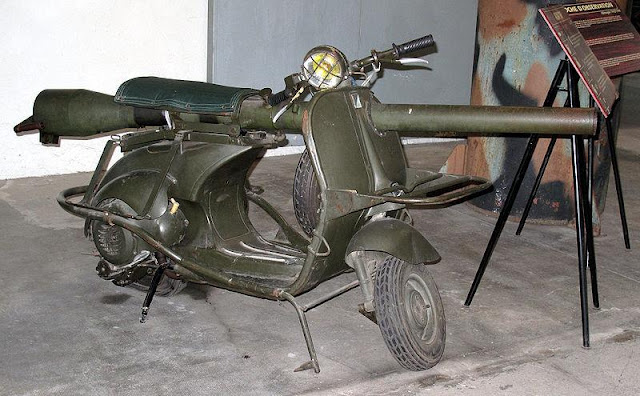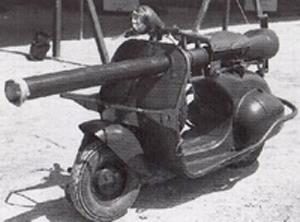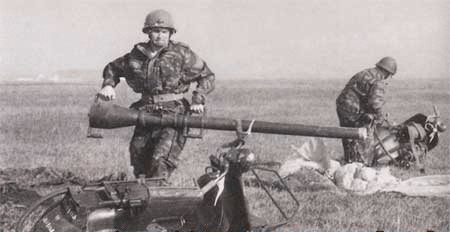September 19, 2010 – 1:41 am
 |
| Vespa 150 TAP 1956-1959 |
Vespa 150 TAP Specifications :
Manufacturer : Piaggio (France)
Productions : 1950′s
Photo Credit : Rama and symboles-et-traditions.com
The Vespa 150 TAP is an Italian Vespa scooter modified to transport a M20 75 mm recoilless rifle, which was used in the 1950s by the French Airborne Forces (Troupes aéroportées, or TAP). It was produced by Ateliers de Construction de Motocycles et Automobiles (ACMA), a licensed assembler of Vespas in France, in 1956 and 1959.
Its mounted M20, a U.S.-made light anti-armour cannon, was very light when compared to a standard 75mm cannon but was still able to penetrate 100 mm of armour by so-called HEAT warhead. The recoil is counteracted by venting propellant gases out the rear of the weapon which eliminated the need for a mechanical recoil system or heavy mounts, enabling the weapon to be fired from the Vespa frame.
 |
| Vespa 150 TAP 1956-1959 |
 |
| Vespa 150 TAP 1956-1959 |
The scooters would be parachute-dropped in pairs, accompanied by a two-man team. The gun was carried on one scooter, while the ammunition was loaded on the other. Due to the lack of any kind of aiming devices the recoilless rifle was never designed to be fired from the scooter, the gun was mounted on a tripod which was also carried by the scooter, before being fired.
The “Bazooka Vespa” was relatively cheap: Vespas cost roughly $500 at the time, and the M20s were plentiful. Roughly 800 of these scooters were deployed in the Algerian War.
 |
| Vespa 150 TAP 1956-1959 |
Source : wikipedia.org
January 27, 2011 – 2:10 pm
Hercules “Popular” Model 1930 Specification:
 Manufacturer : Hercules
Manufacturer : Hercules
 Productions : 1930
Productions : 1930
 Source : bbbicycles.wordpress.com
Source : bbbicycles.wordpress.com
April 12, 2011 – 11:15 pm
Hercules 4 1967 Specification:
 Manufacturer : Hercules
Manufacturer : Hercules
 Productions : 1967
Productions : 1967
 Source : bbbicycles.wordpress.com
Source : bbbicycles.wordpress.com
February 24, 2011 – 10:39 pm
Hercules Roadster 1967 Specification :
 Manufacturer : Hercules
Manufacturer : Hercules
 Productions : 1967
Productions : 1967
 Source : bbbicycles.wordpress.com
Source : bbbicycles.wordpress.com
 Manufacturer : Bentley
Manufacturer : Bentley
 Productions : 1956-1959
Productions : 1956-1959
 Engine : 4.9 L (4887 cc/298 in³) straight-6
Engine : 4.9 L (4887 cc/298 in³) straight-6
 Transmission : 4-speed automatic transmission was standard, with a 4-speed manual available as an option
Transmission : 4-speed automatic transmission was standard, with a 4-speed manual available as an option
 Source : netcarshow.com
Source : netcarshow.com
The Bentley S1 was a luxury car produced by Bentley Motors Limited from 1956 through 1959. It marked Bentley parent, Rolls-Royce, reducing the differences between their Bentley and Roll-Royce models, with the S1 differing only in its radiator design and badging from the Rolls-Royce Silver Cloud I.
The models shared the 4.9 L (4887 cc/298 in³) straight-6 engine, with this being the last vehicle to use this engine. The bore was 95.25 mm (3.7 in) and the stroke was 114.3 mm (4.5 in). Twin SU carburetors were fitted, with upgraded models from 1957. A 4-speed automatic transmission was standard, with a 4-speed manual available as an option. Two wheelbases were produced: 123 in (3124 mm) and, from 1957, 127 in (3226 mm).
Tags 1956-1959, Bentley, S1 Continental |
 Manufacturer : Aston Martin
Manufacturer : Aston Martin
 Productions : 1956
Productions : 1956
 Engine : dohc I-6, 3995 cc, 282 bhp @ 5500 rpm, 288 lbs-ft @ 3850 rpm (Vantage: 325 bhp @ 5750 rpm)
Engine : dohc I-6, 3995 cc, 282 bhp @ 5500 rpm, 288 lbs-ft @ 3850 rpm (Vantage: 325 bhp @ 5750 rpm)
 Transmission : ZF 5-speed overdrive manual or Borg-Warner 3-speed automatic
Transmission : ZF 5-speed overdrive manual or Borg-Warner 3-speed automatic
 Source : netcarshow.com
Source : netcarshow.com
The Aston Martin DB4 through the DB5, the new model was announced at the London Motor Show in October 1965. The most noticeable styling change on the Aston Martin DB6 was the spoiler – then called a Kamm tail – integrated into the tail of the car, which improved high speed stability. The split front and rear bumpers; a redesigned oil cooler opening in the front valance, a higher roof (136 cm) and longer wheelbase (258.5 cm), 9.5 cm more than the DB5, giving an overall length of 462 cm.
read more »
 Manufacturer : Aston Martin
Manufacturer : Aston Martin
 Productions : 1953
Productions : 1953
 Engine : 133 hp (99 kW) 2.6 straight-6 engine
Engine : 133 hp (99 kW) 2.6 straight-6 engine
 Source : netcarshow.com
Source : netcarshow.com
The Aston Martin DB3S was a lighter version of the car, introduced in 1953. It was somewhat more successful, and was produced until 1956. Two coupe versions were also built.
The Aston Martin DB3S was replaced in 1956 by the famed Aston Martin DBR1, which finally claimed Le Mans in 1959.
1959 Aston Martin DBR4
 Manufacturer : Aston Martin
Manufacturer : Aston Martin
 Productions : October 1958 – June 1963
Productions : October 1958 – June 1963
 Engine : all dohc I-6, 3670 cc, 240 bhp @ 5500 rpm, 240 lbs-ft @4250 rpm; Vantage: 266 bhp @5750 rpm
Engine : all dohc I-6, 3670 cc, 240 bhp @ 5500 rpm, 240 lbs-ft @4250 rpm; Vantage: 266 bhp @5750 rpm
 Transmission : 4-speed manual with optional overdrive or optional Borg-Warner 3-speed automatic
Transmission : 4-speed manual with optional overdrive or optional Borg-Warner 3-speed automatic
 Source : netcarshow.com
Source : netcarshow.com
Work on the DB4 started in 1956, at the same time as the DB Mark III. The key people involved in the development of the DB4 were general manager John Wyer, chassis designer Harold Beach, and engine designer Tadek Marek. Every major component in the DB4 was new. The four-seater body was design by Carrozzeria Touring of Milan, using their ‘Superleggera’ system by which alloy panels are fixed to a tubular frame built onto the very strong platform chassis.
The entirely new car was shown at the London Motor show in 1958, sharing a stand with the DB Mark III which was to continue in production for almost a year. The DB4 was the first production car to capable of 0-100-0 mph in under 30 sec. claiming to reach the 100 mph mark in 21 seconds. A very impressive car that put Aston Martin back in competition with other Mediterranean sports car manufacturers.
A four-seater convertible was announced at the London Motor Show in 1961.
April 27, 2011 – 12:56 am
 Manufacturer : Aston Martin
Manufacturer : Aston Martin
 Productions : October 1958 – June 1963
Productions : October 1958 – June 1963
 Engine : all dohc I-6, 3670 cc, 240 bhp @ 5500 rpm, 240 lbs-ft @4250 rpm; Vantage: 266 bhp @5750 rpm
Engine : all dohc I-6, 3670 cc, 240 bhp @ 5500 rpm, 240 lbs-ft @4250 rpm; Vantage: 266 bhp @5750 rpm
 Transmission : 4-speed manual with optional overdrive or optional Borg-Warner 3-speed automatic
Transmission : 4-speed manual with optional overdrive or optional Borg-Warner 3-speed automatic
 Source : netcarshow.com
Source : netcarshow.com
Work on the Aston Martin DB4 started in 1956, at the same time as the Aston Martin DB Mark III. The key people involved in the development of the Aston Martin DB4 were general manager John Wyer, chassis designer Harold Beach, and engine designer Tadek Marek. Every major component in the Aston Martin DB4 was new. The four-seater body was design by Carrozzeria Touring of Milan, using their ‘Superleggera’ system by which alloy panels are fixed to a tubular frame built onto the very strong platform chassis.
read more »















